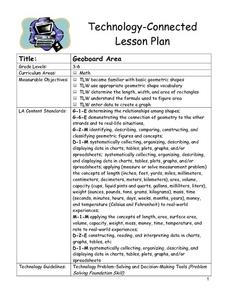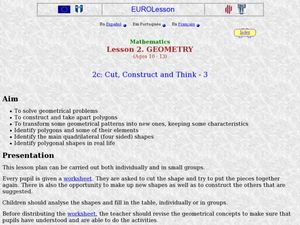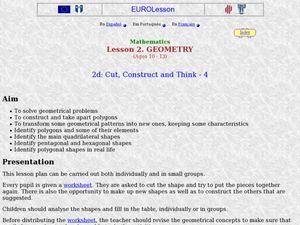Curated OER
Cutting Corners
Second graders examine two-dimensional shapes using their characteristics. In this shapes instructional activity, 2nd graders identify similarities and differences by using cut out shapes, diagrams, mirrors, and graphic organizers.
Curated OER
Cut, Construct and Think
Students complete geometrical shapes construction activities. In this geometrical concepts lesson, students cut shapes from a worksheet to create a geometrical study activity. Students analyze their shapes and complete a table. Students...
Curated OER
Symmetry that is Basic and Beautiful
Learners explore lines of symmetry. In this symmetry lesson, students divide and combine shapes along basic lines of symmetry. Learners explore symmetry in real life objects.
Curated OER
A Shape-Note Singing Lesson
Young scholars discover the shape-note method of singing. In this reading and notating music lesson plan, students learn the four shapes of the shape-note method and the tradition of Sacred Harp singers. Young scholars sing the shapes of...
Curated OER
Where in the World War? Mapping the Geography of D-Day
Students examine how to read maps for historical information. They listen to a lecture on the history of D-Day, analyze a historical map of the invasion of Normandy, and answer discussion questions.
Curated OER
Geoboard Area
Students explore the basic geometric shapes and geometric shape vocabulary through the use of geoboards and virtual geoboards. They create a variety of shapes with a partner, build ten different rectangles on their geoboards, and...
Curated OER
Falling Into Geometry Through Paper Art
Students explore geometric shapes. In this kindergarten geometry lesson, students create a fall quilt consisting of three different paper geometric quilt squares that when assembled form a scarecrow, a pumpkin, and a crow. ...
Curated OER
Buttons, Buttons, Everywhere!
Students compare, sort, and describe shapes. Using a button collection, students identify the shape, color number of holes, etc. Students play a description game with the buttons. They create a chart and name items that are the same...
Curated OER
The Same, Similar, and Different
In this same, similar, and different worksheet, students compare seven shapes and fill in the blanks with like or alike. Students answer eight comparisons.
Curated OER
Angles Everywhere
First graders find angles in their classroom. In this geometric figures lesson plan, 1st graders identify, describe and classify angles they see in their world. Students create pictures that contain angles and display them in the room.
Curated OER
Patterns Here, There, and Everywhere!
Upper graders access the Microsoft Word program and create patterns by utilizing certain keys on the keyboard. They create picket fences, smiley faces, and hearts. It seems that this lesson has as much to do with keyboarding skills as it...
Curated OER
3-D Paper Sculpture
Students explore characteristics of geometric shapes. They participate in a paper folding activity to create various geometric shapes. Students design a mobile of the shapes they have created.
Curated OER
Cut, Construct and Think 3
Students identify and create shapes. In this geometric shapes lesson, students identify various polygons and try to create new shapes using existing polygons.
Curated OER
Cut, Construct and Think - 4
Young scholars identify polygons. For this geometric shapes lesson, students identify and describe polygons. Young scholars create new shapes out of the shapes they are given.
Curated OER
I've Seen That Shape Before
Students identify geometric solids. In this shape lesson plan, students explore the characteristics of geometric solids. They locate pictures of shapes on the internet, and identify the shapes. Students draw pictures of...
Curated OER
Problem Solving Using Power Polygons
Students investigate geometric shapes by creating figures on a plane. In this polygon lesson, students complete a worksheet based on the angles in a power polygon. Students identify the different types of polygons and define their...
Mathematics Vision Project
Module 5: Modeling with Geometry
Solids come in many shapes and sizes. Using geometry, scholars create two-dimensional cross-sections of various three-dimensional objects. They develop the lesson further by finding the volume of solids. The module then shifts...
American Museum of Natural History
Thinking in the Three Dimensions
Discover different dimensions with paper folding. Pupils first read about zero, one, two, and three dimensions, and then learn about the fourth dimension, time. They then use origami to create models of shapes in three dimensions and use...
Teach Engineering
Let's Take a Spin: One-Axis Rotation
Investigate the effect of one-axis rotations on geometric figures. Scholars learn to use snap cubes and the right-hand rule to draw figures after rotations about the x-, y-, or z-axes. They try their hands at examples created by the...
Statistics Education Web
It Creeps. It Crawls. Watch Out For The Blob!
How do you find the area of an irregular shape? Class members calculate the area of an irregular shape by finding the area of a random sampling of the shape. Individuals then utilize a confidence interval to improve accuracy and use a...
Teach Engineering
New Perspectives: Two-Axis Rotation
Two-axis rotations ... twice the fun as one-axis rotations! The last installment of a five-part module teaches scholars how to conduct two-axis rotations. They create isometric drawings before and after the rotations.
Union County Vocational Technical Schools
Engineering Drawing
Knowing the basics of drafting allows individuals to create drawings that show all the views and measurements necessary to allow others to visualize the original object. Pupils gain experience by drawing three orthographic views of...
Curated OER
Grade 3: What Can I Make with 30 Centimeters?
Third graders create polygons with perimeters of 30 centimeters, use the centimeter grid paper to determine the area of each shape, and organize the shapes to make generalizations from the patterns they see.
Curated OER
Mandalas, Polygons and Symmetry
Students create a geometric pattern using mandalas, polygons and symmetry. In this geometry lesson, students analyze the mathematics involved in making the mandalas, including the shapes and symmetry. Students create their own mandalas...























